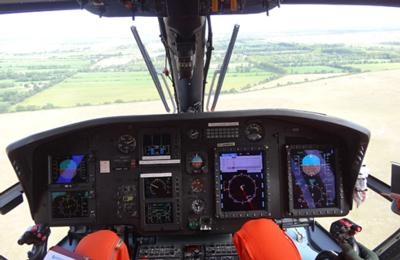Tue, Jul 16, 2013
Augmented Satellite Approaches Lead To Quieter Helicopter Landing Procedures
Eurocopter has successfully demonstrated new landing procedures relying on augmented satellite guidance that can be tailored to more completely comply with the local environmental requirements. These new landing procedures were validated with a twin-engine Eurocopter EC155 during flight tests performed as part of the company’s participation in the Green Rotorcraft Integrated Technology Demonstrator program – which is part of Europe’s Clean Sky Joint Technology Initiative.

Eurocopter’s validation flights demonstrated significant reductions in the helicopter’s perceived sound footprint - consistent with predictions. They also confirmed that such automated low-noise approaches could be tailored to local environmental requirements, thereby optimizing Eurocopter helicopter operations for even the most sensitive environments.
The flight testing involved the use of optimized noise abatement flight paths compatible with Instrument Flight Rules (IFR) operations. During the EC155’s landing approaches, vertical guidance was provided by EGNOS, the European Satellite-Based Augmentation System (SBAS), with the helicopter’s Flight Management System (FMS) coupled to the Automatic Flight Control System (AFCS). This enabled the new approach profiles to be flown accurately, minimizing the pilot workload with an automatic monitoring of speed profiles and ascent/descent rates.
“Improving the neighbor-friendly aspects of rotorcraft continues to be a priority for us, and these new tests underscore how advanced flight guidance systems can be brought together with the latest navigation technologies to reduce perceived sound,” said Yves Favennec, Vice-President of Research at Eurocopter.
The Green Rotorcraft Integrated Technology Demonstrator program that supported Eurocopter’s EC155 flight evaluations is part of the Clean Sky Joint Technology Initiative, which is Europe’s most ambitious aeronautical research program ever. Clean Sky’s goal is to develop breakthrough technologies that significantly increase environmental performance of the air transport sector, resulting in quieter and more fuel efficient aircraft and rotorcraft
Eurocopter is a founding member of the Clean Sky Joint Technology Initiative, and recently joined with its other members to propose an extension of this effort during the 2014-2024 time period.
(Image provided by Eurocopter.)
More News
With Testing Soon Complete, Launch Preparations Begin in Earnest Sierra Space's Dream Chaser has been put through the wringer at NASA's Glenn Armstrong Test Facility in Ohio, but w>[...]
Takeoff Roll The process whereby an aircraft is aligned with the runway centerline and the aircraft is moving with the intent to take off. For helicopters, this pertains to the act>[...]
“We’re proud of the hard work that went into receiving this validation, and it will be a welcome relief to our customers in the European Union. We couldn’t be mor>[...]
"Aircraft Spruce is pleased to announce the acquisition of the parts distribution operations of Wag-Aero. Wag-Aero was founded in the 1960’s by Dick and Bobbie Wagner in the >[...]
IDENT Feature The special feature in the Air Traffic Control Radar Beacon System (ATCRBS) equipment. It is used to immediately distinguish one displayed beacon target from other be>[...]
 Sierra Space Repositions Dream Chaser for First Mission
Sierra Space Repositions Dream Chaser for First Mission ANN's Daily Aero-Term (05.10.24): Takeoff Roll
ANN's Daily Aero-Term (05.10.24): Takeoff Roll Aero-News: Quote of the Day (05.10.24)
Aero-News: Quote of the Day (05.10.24) Aero-News: Quote of the Day (05.11.24)
Aero-News: Quote of the Day (05.11.24) ANN's Daily Aero-Term (05.11.24): IDENT Feature
ANN's Daily Aero-Term (05.11.24): IDENT Feature



